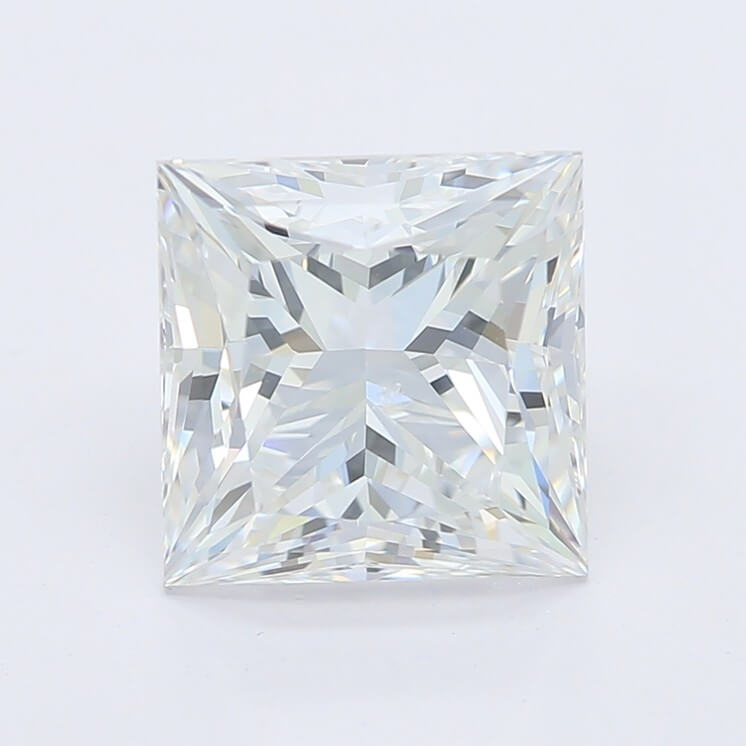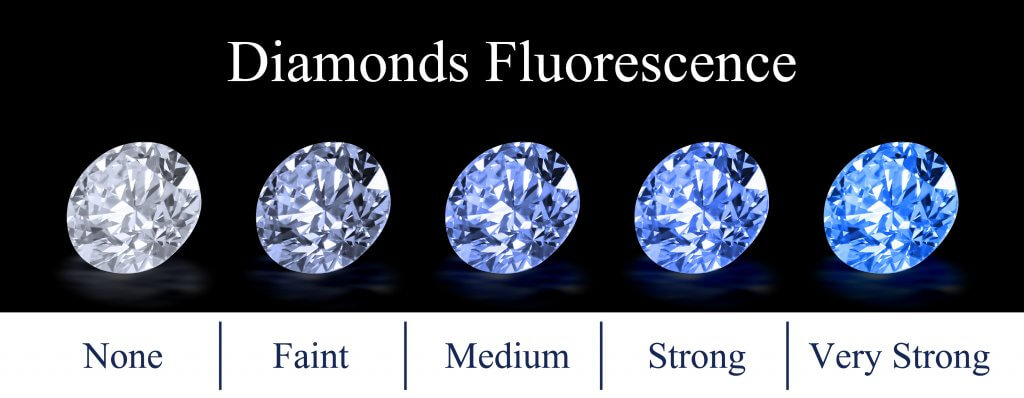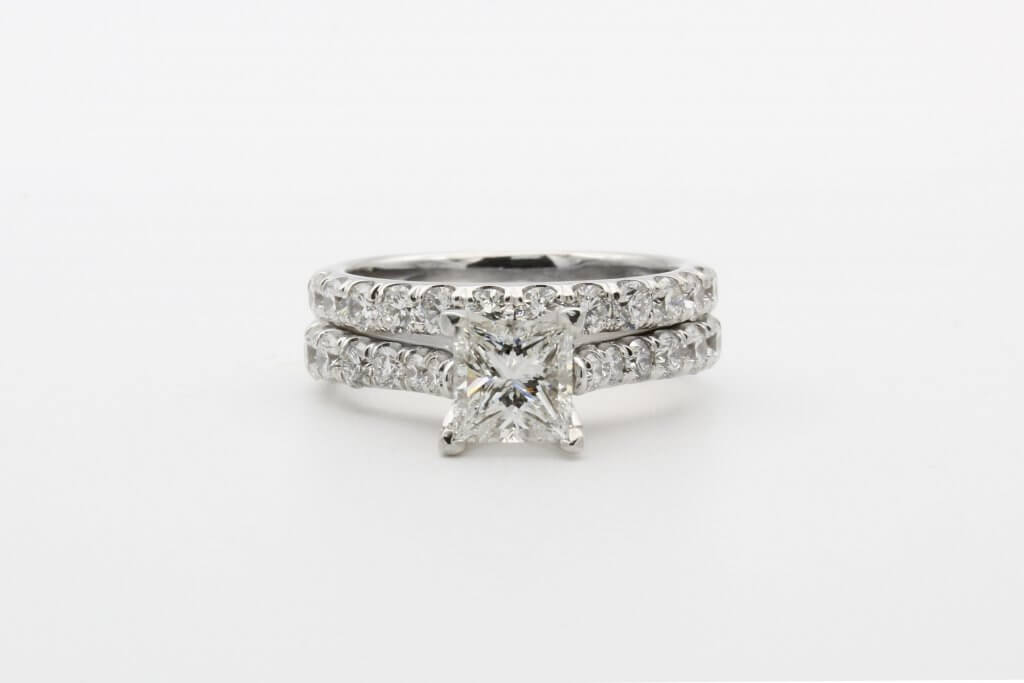Everything You Need to Know About E Color Diamonds
Key Takeaways
- The E Color grade is the second best grade you could hope to find, according to the GIA’s Color scale.
- Second only to D diamonds, E diamonds are virtually free of any color – and even a very, very large E color diamond will look totally colorless without strong magnification, powerful lighting, and an expert eye.
- E color diamonds are also very expensive, but definitely not worth the cost.
- Plenty of other Color grades, all the way down to J, can appear colorless, so paying for an E diamond means paying for invisible traits.
- Don’t waste your budget on an E color diamond.

Finding a clear, icy diamond should be at the top of any budding diamond buyer’s list. Like any of the Four Cs, color is one of the most potentially divisive factors, and influential enough to turn an otherwise beautiful, clear, and sparkling diamond into something 99% of shoppers won’t look twice at.
This is why the GIA first introduced the Color Scale, way back in the 1940s. Instead of staring into diamonds for hours on end, talking yourself into seeing yellow behind every facet, you can use the stone’s color grade as a good indicator of how clear (or how discolored) it is, and will look when worn on the finger.
Nevertheless, you’ve got to understand it first – and what better place to start than right up near the very top with E diamonds?
What is E Color in a Diamond?
An E Color diamond is one that has been graded according to the GIA’s rigorous standards for diamond color, and determined to be part of the sought-after category of ‘Colorless’ diamonds.
While it may sound confusing at first, the GIA Color Scale begins at D and works its way down to Z from there. As such, a D color diamond is the best you can get – absolutely free from any discernible color, even when viewed under ideal lighting and magnification. As a result, these diamonds are incredibly rare – and, accordingly, highly valuable.
E is, of course, the second highest grade on the scale, and refers to another rare group of diamonds with only marginally more color than D diamonds. So marginal, in fact, that even an expert diamond grader would need ideal lighting and strong magnification to identify it.
What Does an E Color Diamond Look Like?
Clear and bright, and free from even the vaguest tint of yellow or brown to the naked eye.
In other words, an E color diamond looks like a D color diamond. As we said above, any attempt to tell the difference between the two without the right equipment would be nothing more than a guessing game, since the difference between the two grades is so minor.
This is why D and E grades – and, of course, the F color grade – all fall into the same category: Colorless.
This can be a little confusing since, if all three are colorless, it would be simpler to give them all the same grade. This is true for casual shoppers looking for diamonds to place in jewelry but, for avid collectors, even that barely tangible difference between an E diamond and a D diamond can be cause enough to spend thousands of dollars more.
If you want to be confused even further, then consider this: while, to the naked eye, E color diamonds look like D color diamonds, they also look like diamonds even further down the color scale, too. True, some gemologists will spot the difference way before non-experts can but, in all likelihood, your future bride is not a gemologist.
Are E Diamonds Rare?
Yes, E color diamonds are very rare – and this is one of the reasons why they are so popular among collectors. The average first-time buyer looking for an engagement ring? Not so much.
The likelihood of a natural diamond forming under the formidable conditions found so many miles beneath the earth’s surface is very, very slim. This is the same reason why Flawless diamonds are so rare – it is all too easy for other substances to get caught within the developing diamond, and to interfere with that stone’s natural beauty.
It’s much more common for diamonds to be included and colored than it is for them to be perfect, although in many cases these flaws are only visible under magnification.
How Much Does a 1 Carat E Diamond Cost?
Anywhere from around $2,000 (if the diamond is particularly small or otherwise poor quality) to $20,000.
A diamond’s value is determined by its quality – color, of course, as well as clarity and cut – and, of course, its size, with the value of equally high quality diamonds increasing exponentially with carat weight.
If you had your sights set on, say, a 4 carat diamond that checks all the boxes in terms of color, cut and clarity, then you would have to be prepared to pay a major premium – well into the five figure range.
If, however, you were looking at an E color diamond with significant, visible inclusions, a poor cut, or a carat weight below one, then the price would be thousands of dollars lower – although, as we’ll explain below, any reputable jeweler would likely try to talk you out of that purchase.
Suffice to say for now that diamond color is not everything, and that there are certain factors you should be investing more of your budget into than color.
Is E Better Than F in Diamonds?
Yes but, again, only marginally. F is also one of the colorless grades, meaning that, to the naked eye, there is no discernible difference between E and F diamonds.
That’s not to say that E diamonds represent better investments than F diamonds. Unless you’re a collector, then the difference between any of these grades is pretty meaningless – it’s a difference that is recorded on paper, within the diamond’s GIA Report, but not one that will have an impact on the overall appearance of your engagement ring.
If it’s a question of E vs F then, unless your budget has no end, we would always encourage you to focus on F color diamonds and invest more of your budget into the rest of the Four Cs. Nevertheless, this argument can hold true even further down the color scale, so don’t settle on F color diamonds just yet…

Can You Tell the Difference Between E and G Diamonds?
No, chances are you won’t be able to tell any difference between E and G diamonds unless you’re a skilled and experienced gemologist or jeweler.
G color diamonds represent the fourth color grade, and the first of the category termed ‘Near Colorless’ by the GIA. This means that they hold a pretty strong position, being as close to colorless as possible without the high price tag given to diamonds that are considered to be Colorless.
Take a look at this E color 1 Carat VS2 Round Diamond, then compare it with this G color 1.37 carat VS2 Round Diamond. Can’t spot any difference between the two? That’s because, for the most part, the differences are far too minor to detect without proper lighting and magnification, meaning that both diamonds will look equally beautiful in jewelry.
What does that mean for you? Money saved – potentially thousands of dollars – simply by switching from the Colorless grades to the Near Colorless grades.
Is an E SI1 Diamond Good?
It’s not quite ideal. While SI1 diamonds can often present as eye clean, there’s quite an imbalance between the incredibly high quality of an E color diamond, and a pretty low clarity grade.
We’re definitely proponents of SI1 diamonds, provided you can find one that appears eye clean. It can, however, be much harder to find larger diamonds without visible inclusions at this clarity grade, which is why it’s better for some shoppers to aim a little higher and target VS diamonds.
There’s nothing wrong with picking an E color diamond if you can afford it, but not if it means sacrificing clarity. Since you can afford to go further down the color scale without the losing any of the diamond’s beauty, we’d recommend looking at a Nearly Colorless diamond with a VS1 or VS2 clarity grade instead.
For instance, this 1.7 Carat H-VS2 Oval Diamond will look clear and eye clean, without requiring you to invest so much into color.
So, is an E Color Diamond Good?
Objectively, and according to the GIA color scale, yes, E color diamonds are among the most coveted specimens in the world. But do you really want a ‘specimen’ for your engagement ring, or just a beautiful stone that looks perfect until it’s scrutinized under the magnifying glass?
Yes, we get it, there’s something pretty seductive about a diamond that is verging on perfect. The E color grade, if you can get your hands on it, definitely commands a certain amount of prestige, even if you can’t always see it for yourself.
Then again, most shoppers really can’t afford to invest into an E color diamond. Yes, you might be able to find one within your budget, but what will you have to sacrifice? If the answer to that question is clarity, cut or carat weight, then you can’t afford to invest in an E color diamond.
Fortunately, this is no big deal. As we mentioned above, plenty of color grades that sit below E on the scale will appear almost (if not totally) identical to an E diamond, while costing thousands of dollars less. In this way, you don’t need to sacrifice the most important aspect: the diamond’s overall beauty.

Jul 18, 2022 By Willyou.net
The Negative Effects Of Fluorescence On Diamond Appearance

Sep 10, 2021 By Willyou.net
Are J Color Diamonds Best Bang For Your Buck?








